
Inbound Marketing For Financial Advisors
Nowadays, financial advisors are looking for effective alternative ways to promote their solutions and bring in more customers. Inbound marketing has become financial service providers’ most beneficial and cost-effective strategy.
But what is inbound marketing for financial advisors? Well, it is an investor-centric marketing approach. In a broader sense, inbound marketing for financial advisors is a marketing strategy that focuses on attracting leads to the financial advisor websites and converting those leads into clients.
A financial advisor analyzes the financial needs of individuals and advises them with decisions. But first, they need to attract individuals with their financial services. For that, the effectiveness of inbound marketing strategies is inevitable.
This blog will discuss the effective inbound marketing strategies to grow your financial advisory firm, its challenges, and the ways of success.
What's Inside
- Why Should Financial Advisors Use Inbound Marketing?
- 3 Most Effective Inbound Marketing Strategies for Financial Advisors
- Additional Inbound Marketing Technique: Local SEO
- Challenges in Inbound Marketing for Financial Advisors and How to Overcome Them
- Measuring the Success of Your Inbound Marketing Strategies
- Conclusion
Why Should Financial Advisors Use Inbound Marketing?
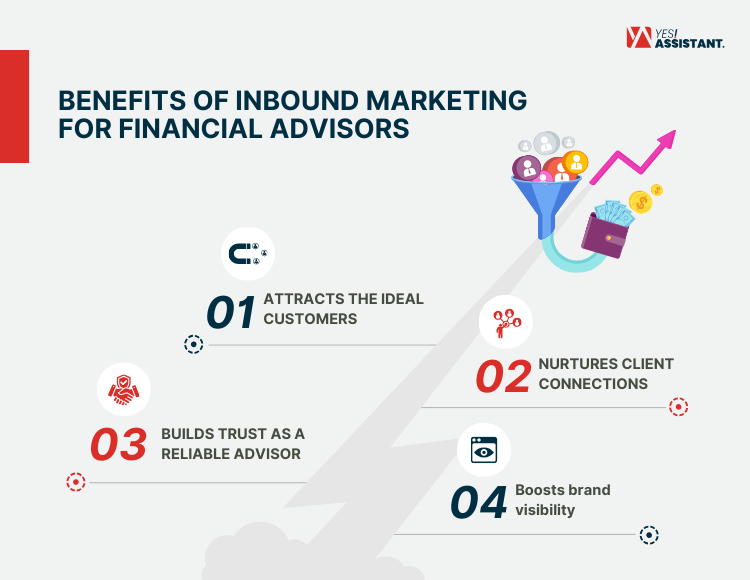
Inbound marketing is an approach for financial advisors that focuses on attracting and bringing new consumers to their financial advisory firm by creating relevant and valuable content.
Most potential consumers conduct extensive online research before reaching out to a firm. According to the research of Invoca, 90% of loan & mortgage, 85% of check cashing, and 76% of tax return preparation consumers ran an online search before converting.
Inbound marketing is the best way to reach potential prospects and establish trust and credibility. This marketing approach helps to guide customers to your services rather than competitors.
This marketing technique is beneficial to financial advisors for numerous reasons. Let’s look at the reasons why financial advisors should use inbound marketing:
- Attracts the ideal customers
- Establishes you as a trusted advisor
- Showcases your expertise and knowledge
- Builds meaningful relationships with clients
- Increases brand awareness
- Cost-effective
- Ensures high return on investment (ROI)
For these reasons, you need inbound strategies to engage with more ideal consumers and grow your firm effectively.
3 Most Effective Inbound Marketing Strategies for Financial Advisors
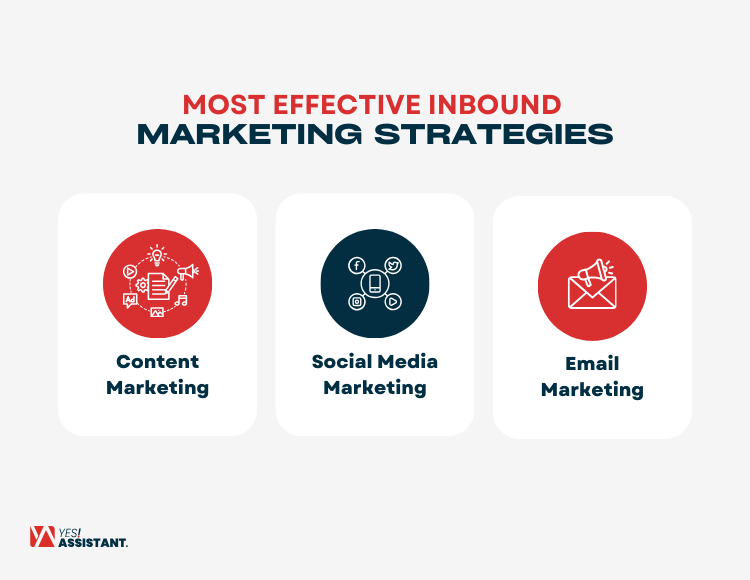
Inbound marketing for financial advisors is highly significant for generating better results. It is a continuous process that adds value to the consumers.
Before starting your inbound marketing campaign, you must set Specific, Measurable, Achievable, Relevant, and Time-bound (SMART) goals. Goal setting is important to inbound marketing for clear direction and focus on your marketing efforts.
After setting a SMART goal, you must determine how to start your inbound marketing campaign. Here is an in-depth discussion of the most effective inbound marketing strategies for financial advisors.
1. Content Marketing
Content marketing involves creating and sharing valuable content to attract, engage, and educate your target audience. It is the base for successful inbound marketing for financial advisors.
Contents such as blog posts, e-books, whitepapers, videos, webinars, and infographics can be a part of your content marketing campaign.
Benefits Of Content Marketing For Financial Advisors
Content marketing strategy is best for financial advisors to engage and generate quality leads. Audiences have an average of 1 minute and 51 seconds attention rate while engaging with financial service-related content.
Financial advisors educate clients with valuable knowledge, build trust and credibility, and enhance their online presence by leveraging content marketing.
Now, let’s take a look at how inbound content marketing strategies can benefit you.
- Educating Clients And Prospects: With content marketing, financial advisors become educators in their field. You can educate clients and prospects to make informed financial decisions by providing informative articles, guides, and insights. It will develop trust and establish you as a helpful asset.
- Positioning Yourself As An Industry Expert: Expertise is the most crucial thing in the finance industry. Clients and prospects will come to you if they find you as a financial advisor expert in this industry. Through content marketing, you can showcase your in-depth knowledge, experience, and insights on the latest trends in the industry. It will help you to position yourself as an industry expert and a leader in your field.
- Boosting Search Engine Ranking: High-quality content boosts your search engine rankings. If you can produce valuable articles and optimize them for SEO, you can increase your search engine authority. Top-notch content can improve your finance website’s visibility and attract more organic traffic and potential clients.
Types Of Content Financial Advisors Should Consider
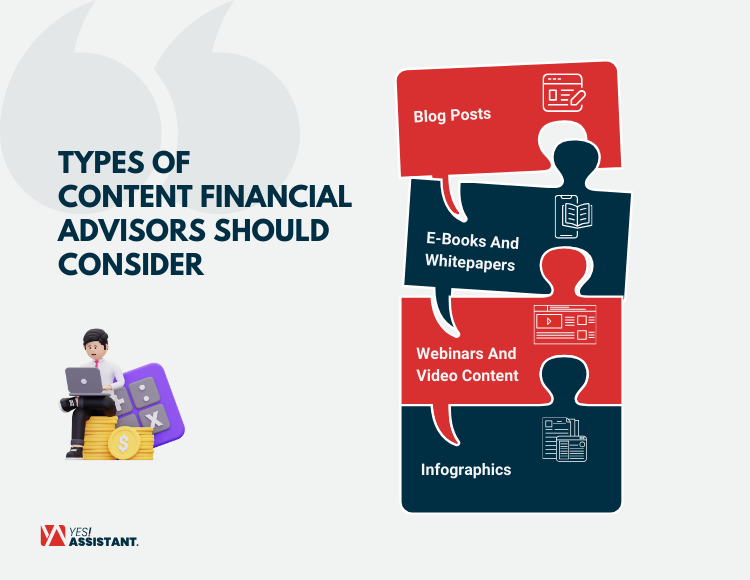
Financial clients prefer informative and educational content relevant to their specific needs. Several forms of online content can be used in your financial advisor content marketing campaign.
Let’s explore the content formats that can be effective for your inbound marketing for financial advisors.
- Blog Posts
Blogs or articles are best for sharing your insights on the latest trends and challenges and providing actionable solutions. These posts will cover various topics related to the finance industry.
Blog posts provide helpful tips to your clients and establish your authority in the field. Regularly updated blog posts keep your website fresh and attract organic traffic from search engines.
- E-Books And Whitepapers
E-books and whitepapers are longer content forms that provide in-depth knowledge of a particular topic. This form of content helps you educate your clients on complex topics such as retirement or estate planning. Downloadable e-books and whitepapers will help collect valuable visitors’ contact information.
- Webinars And Video Content
Webinars and video content are engaging ways to connect with your audience personally. Video content helps you to simplify complex financial concepts and explain how you can help them with your services.
- Infographics
Infographics help you to demonstrate complex data in a simple and easy-to-understand way. Infographics simplify complex information, making it easier for clients and prospects to understand key financial concepts.
2. Social Media Marketing
Social media is a powerful platform for financial advisors to engage with clients and prospects. Inbound marketing for social media helps to connect with desired prospects, share valuable content, and build a community around your firm.
Benefits of Social Media for Financial Advisors
You can stay connected with your prospects and share content more broadly by leveraging social media platforms. Social media platforms such as LinkedIn, Facebook, Instagram, and Twitter help you reach potential clients and develop personal relationships.
It also increases your reputation in the industry. You must maintain interaction with your followers by participating in online discussions and replying to their messages and comments.
Social media marketing helps you to encourage prospects to choose your service. It provides the opportunity to engage and communicate directly with clients and prospects. Moreover, if you want to attract local prospects, you can use hyperlocal social media marketing. It will improve your brand awareness and build your brand in the local community.
Though some common issues with social media marketing plans may occur, it is possible to overcome them with proper planning and execution.
Take a close look at the benefits of social media for financial advisors.
- Engaging with a younger demographic
Younger generations are most active on social media platforms. They prefer to connect on social media rather than any other platform. So, it is an effective way to reach younger clients. By being present and active on social media, you can engage with a younger demographic and build relationships that could last a lifetime.
- Direct communication with clients
Social media offers a direct line of communication with your clients and prospects. It helps you to build stronger relationships and foster trust and loyalty. Engage with your clients by providing financial updates, answering questions, sharing valuable real-time insights, and participating in industry-related discussions.
- Building a personal brand
Trust is built on personal relationships in the financial industry. If you can establish yourself as an expert financial advisor, you can build a personal brand. Social media allows you to showcase your expertise in the financial field. It helps you to stand out in a crowded market and build your brand.
Platform-Specific Strategies To Reach Out Potential Clients
Social media is an ideal strategy of inbound marketing for financial advisors to reach out to potential clients. But for that, you must choose the social media platforms where your prospects and clients are most active.
Financial advisors should use these three social media platforms to make their inbound marketing strategy effective.
- LinkedIn: Best For Professionals
LinkedIn is the best social media platform for building a professional network. It is a great platform to connect with other professionals and showcase your expertise. You can learn new financial advising skills from LinkedIn courses and training programs.
- Facebook & Instagram: Best For Young Generation
Facebook and Instagram are best for reaching younger audiences. If your target audience is younger, these platforms can be ideal. By sharing visually appealing content on Facebook and Instagram, you can easily catch the attention of younger clients.
- Twitter: A Bit of Both & Celebrities
Twitter is a versatile social media platform that helps you connect with many clients, including celebrities who may seek your financial advice. Using this platform, you can engage with both professionals and younger clients. Twitter is also popular among celebrities. You can attract them along with other prospects with engaging financial content.
3. Email Marketing
Email marketing is a direct and cost-effective strategy to reach prospects for financial advisors. This marketing strategy helps you to create personalized emails to nurture leads and convert them into clients. You can inform prospects about financial trends and updates and provide tips by creating targeted email campaigns with lead-generation tools.
Benefits of Email Marketing for Financial Advisors
Email marketing is one of any business’s most effective inbound marketing strategies. Almost every person checks their emails daily. 91% of consumers check email at least once a day. So, it is a great inbound marketing for financial advisors strategy to generate leads and boost profits.
Now, let’s find out the benefits email marketing provides for financial advisors.
- Personalized client communication
One of the primary advantages of email marketing is that you can personalize your messages. You can segment your email list based on client behavior, interests, or demographics.
It will enable you to send tailored content addressing each individual’s unique financial needs and concerns. Personalized emails will show clients that you understand them and are committed to meeting their goals.
- Regular touchpoints without being intrusive
Email marketing lets you stay in touch with your clients regularly without being intrusive. You can send informative and relevant content to your prospects, maintaining a suitable schedule to stay on their radar. It will ensure that your firm comes to your prospect’s mind whenever they need a financial service.
- Effective client retention
You can communicate with clients regularly through email marketing, even after taking a service from you. Using email management services, you can re-engage inactive clients and remind them of your expertise and value.
For example, sending periodic investment updates, performance reports, and market insights can reignite their interest and confidence in your services. Email marketing will improve client retention rates and make marketing strategies more effective.
Types of Email Campaigns for Financial Advisors
Now, let’s explore the types of email campaigns that financial advisors can use to engage clients and prospects.
- Monthly newsletters
Monthly newsletters are a great way to share industry insights, financial tips, and updates. Newsletters keep your clients informed about relevant news and trends in the financial world.
- Investment updates
Email marketing helps you to provide your clients with information on why they should invest in financial solutions or how their investments are performing. Discuss the reasons for considering investment and address their concerns proactively through emails.
- Financial tips and insights
Financial tips and insights can help your clients make informed financial decisions. Share your expertise in your emails to position yourself as a knowledgeable and caring advisor. For example, you can provide tax-saving strategies, retirement planning advice, or investment guidance.
- Event invitations or webinars
Hosting exclusive events or webinars for financial advising is a great way to engage clients and prospects. But first, you must invite your clients and prospects to your inbound marketing event or webinar effectively. Email marketing helps you to send invitations with event details, topics to be covered, and registration links.
Additional Inbound Marketing Technique: Local SEO
Local search engine optimization (SEO) helps financial advisors target prospects in their local area through online search results.
Financial advisors must optimize their website and online presence for local search terms such as “financial advisor near me” or “financial planning in [city]” to increase their visibility and ranking on search engines like Google or Bing. This technique attracts more local customers looking for financial advisors nearby.
Local inbound marketing drives more traffic to your website or physical location by providing them with relevant information such as your address, phone number, hours of operation, directions, etc. You can build trust and credibility by showing prospects your reviews, ratings, testimonials, or awards.
Let’s dive deeper to understand how to optimize local SEO to improve inbound marketing for financial advisors.
Google My Business Optimization
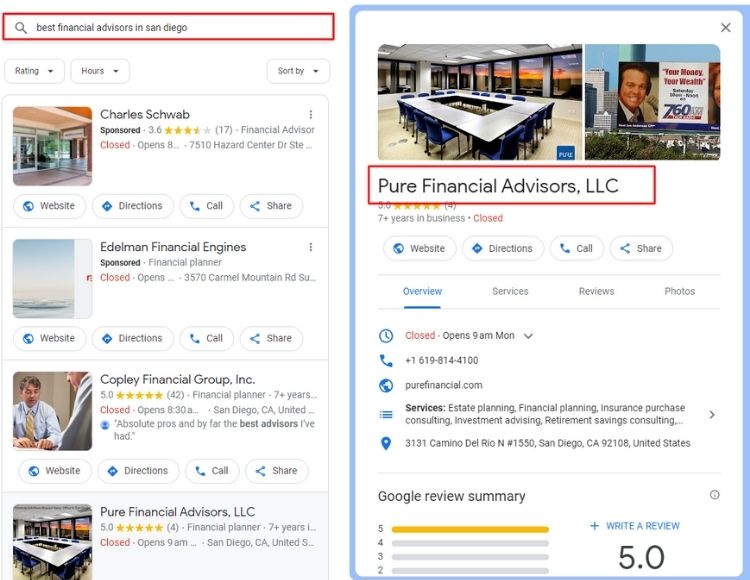
Google My Business (GMB) allows you to create and manage your business profile on Google. It helps you by displaying your business information on Google Search and Maps when someone searches your financial firm’s name or related keywords.
GMB helps you to highlight the value you offer and client satisfaction by showcasing your reviews, ratings, photos, videos, posts, or offers. Respond to their questions, feedback, or messages to maintain client interaction.
To optimize your GMB profile, you must update your business information and add high-quality photos and videos showcasing your business location, team, or work. Also, use keywords or phrases that describe your business and location.
Furthermore, encourage your clients to leave reviews and ratings on your GMB profile. You must respond to them professionally. An optimized Google My Business profile improves your local search visibility, making it easier for prospects to find you.
Local Keyword Research & Optimization
Local keyword research helps to find and analyze the keywords or phrases local users use to search for financial advisors. You have to incorporate those keywords into your website content to improve your ranking and relevance for local search queries.
Focus on the terms that reflect the specific financial planning or advisory services you offer. Utilizing those local keywords, you can optimize your website and increase the chances of appearing in local search results when potential clients seek financial advice.
Map Ranking
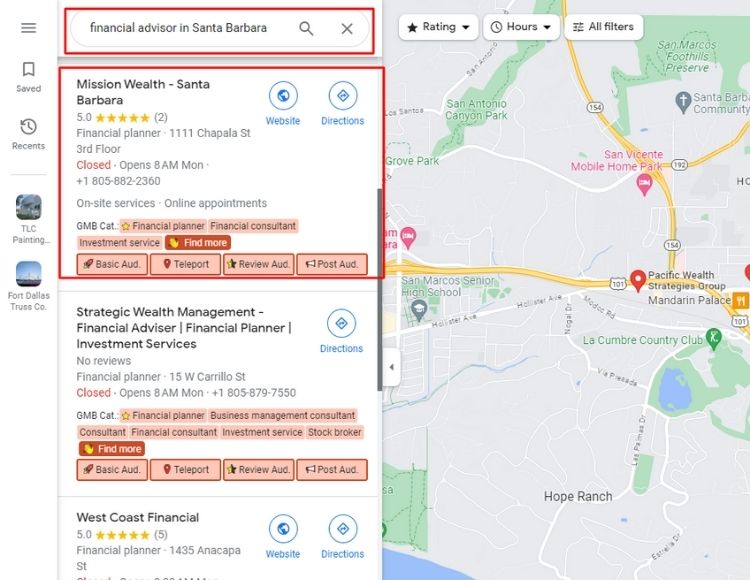
Map ranking is basically the position of your business on Google Maps. It helps to increase your visibility to local users who use Google Maps to find financial advisors. The higher you can position on local maps, the more visible and accessible your services will become.
To improve your map ranking, you have to optimize your GMB profile. Moreover, try to acquire more reviews and ratings from your clients. Positive feedback and reviews play a significant role in boosting your map ranking.
NAP Optimization
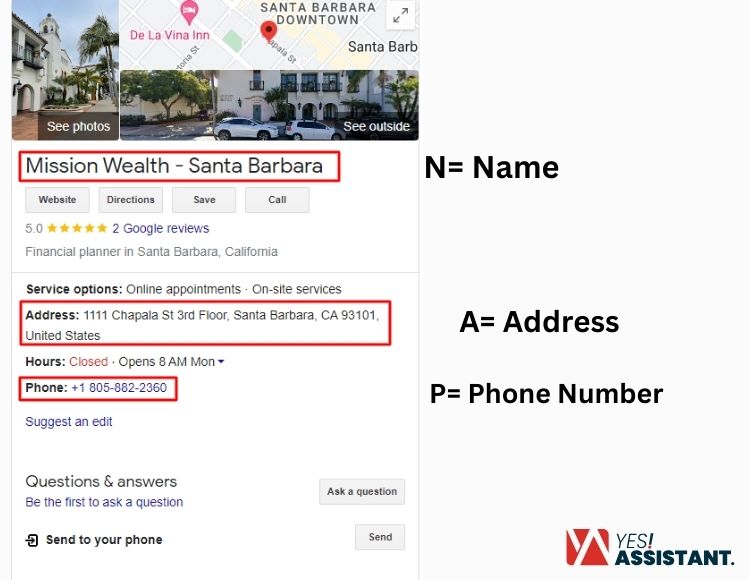
Name, address, and phone number (NAP) are crucial for driving more traffic. Your NAP has to be accurate and consistent across all online platforms for optimizing your website. It will help search engines and potential clients find and trust your firm.
Google only prefers authentic information. So, add the correct information of your name, address, and phone number (NAP) to your GMB profile, website, and social media platforms.
Local Citation
Local citations are online mentions of your business on local business directories, websites and apps, and social platforms. Citation helps people to find a local business. It also helps to improve your online reputation and search engine results.
Local citations boost your visibility in local search results. So, search for opportunities to have your financial advisory business listed on local websites and directories.
Challenges in Inbound Marketing for Financial Advisors and How to Overcome Them
Inbound marketing is an effective strategy for growing your financial advisory business. However, it comes with some challenges that you need to overcome.
Time-consuming
Inbound marketing requires a lot of time and effort to create high-quality content, optimize your website, engage with your audience, and nurture them. As a financial advisor, you may not have enough time to do all these tasks while also managing your current clients and other business activities.
You can overcome this challenge by creating a content calendar to plan and schedule your content in advance. Moreover, you can outsource some of the tasks, such as content creation or social media management, to professionals. You can also invest in marketing automation tools to automate some of the marketing processes and save time.
Competitive
Inbound marketing for financial advisors is becoming more popular. Most financial advisors want to attract clients online, and numerous financial professionals are fighting for the attention of potential clients.
To overcome this challenge, you need to differentiate yourself from your competitors by creating unique and valuable content that showcases your expertise, personality, and value proposition. Also, you can focus on a specific niche or target market that you can serve better than others.
Continuously monitor and analyze your competitors’ strategies to identify gaps and opportunities in the market. Finally, build a solid personal brand to become more memorable and trustworthy in the eyes of potential clients.
Lack of Trust
Financial services involve trust naturally. It is crucial to build trust with clients in the financial industry. However, building trust online can be challenging, especially in an industry that is full of doubt.
You can overcome the lack of trust by building relationships across your client base through content marketing. Content marketing will demonstrate your expertise and commitment to client success. Position yourself as a trusted advisor by providing well-researched content that provides valuable insights into financial planning and investment strategies.
Measuring the Success of Your Inbound Marketing Strategies
Inbound marketing requires constant monitoring and evaluation to measure success. You can measure it by tracking and analyzing the key marketing metrics.
First, measure the number of visitors to your website or other digital platforms to understand how well your inbound marketing strategies are attracting potential clients. Then, measure how much traffic you are converting into leads.
Further, calculate your conversion rate with the percentage of leads who become clients or take a desired action. This metric shows how well you are convincing your leads to do business with you.
Also, calculate the cost of your marketing efforts and the revenue generated from converted leads or clients. You can determine your return on investment (ROI) by comparing the cost and revenue.
You can use Google Analytics to track and analyze these metrics and measure your inbound marketing performance.
Conclusion
Inbound marketing is a blessing for financial advisors to cope with the digital marketing era. With inbound marketing, there is a high chance of getting more clients.
Inbound marketing offers a significant opportunity for financial advisors to achieve success. No matter what your firm size, by utilizing all strategies properly, content creation, email marketing, engaging with local social media, and local SEO, you will surely boost your financial advisory firm.
Inbound marketing for financial advisors can be challenging at times. However, we have shown how to overcome the drawbacks of inbound marketing. So, get started with inbound marketing to expand your financial advisory firm.




